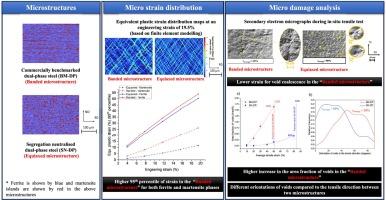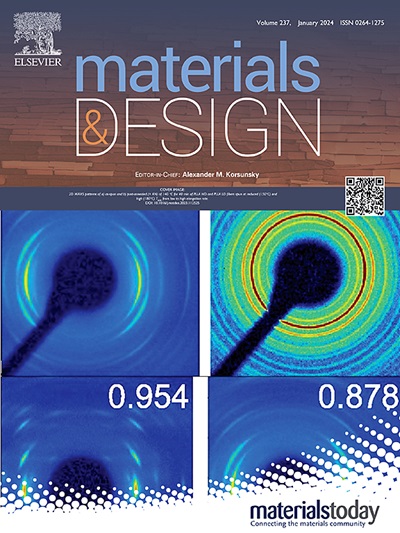Martensite size and morphology influence on strain distribution and micro-damage evolution in dual-phase steels; comparing segregation-neutralised and banded grades
IF 7.6
2区 材料科学
Q1 MATERIALS SCIENCE, MULTIDISCIPLINARY
引用次数: 0
Abstract
A change in strain partitioning and microscale failure mechanisms in dual-phase (DP) steel was found when both the morphology and distribution of martensite were altered compared to a banded DP steel grade benchmarked against a specific commercial DP grade. To achieve a DP microstructure with equiaxed and well-dispersed martensite, the concept of segregation neutralisation was utilised, where the ratio of Mn to Si elements was decreased (from 7.4 to 0.3) to neutralise the effect of Mn segregation on generating the banded martensite. A combination of micromechanical modelling simulations and in-situ notch tensile testing (within an SEM) was employed to compare the micro strain field and void formation rate between the segregation-neutralised and the benchmark grades. The benchmark grade showed extensive void coalescence along the direction of shear bands in the tensile sample after the average tensile strain of 30%. In contrast, no void coalescence was observed in the segregation-neutralised DP steel even at the average tensile strain of 80% just before failure. As a result, post-uniform elongation in the segregation-neutralised grade increased to 63.3%, compared to 30.1% in the benchmark grade.

马氏体尺寸和形态对双相钢中应变分布和微损伤演变的影响;偏析中和带状钢种的比较
当马氏体的形态和分布发生变化时,双相(DP)钢中的应变分配和微观失效机制就会发生变化,而带状双相(DP)钢则以特定的商业双相(DP)钢为基准。为了获得具有等轴和良好分散的马氏体的 DP 显微结构,采用了偏析中和的概念,即降低锰元素与硅元素的比率(从 7.4 降至 0.3),以中和锰偏析对产生带状马氏体的影响。结合微机械建模模拟和原位缺口拉伸测试(在扫描电镜内),比较了偏析中和后的牌号与基准牌号之间的微应变场和空洞形成率。在平均拉伸应变达到 30% 后,基准牌号的拉伸样品沿剪切带方向出现了广泛的空洞凝聚。与此相反,偏析中和的 DP 钢即使在失效前的平均拉伸应变为 80% 时,也未观察到空洞凝聚。因此,偏析中和钢种的均匀后伸长率增至 63.3%,而基准钢种仅为 30.1%。
本文章由计算机程序翻译,如有差异,请以英文原文为准。
求助全文
约1分钟内获得全文
求助全文
来源期刊

Materials & Design
Engineering-Mechanical Engineering
CiteScore
14.30
自引率
7.10%
发文量
1028
审稿时长
85 days
期刊介绍:
Materials and Design is a multi-disciplinary journal that publishes original research reports, review articles, and express communications. The journal focuses on studying the structure and properties of inorganic and organic materials, advancements in synthesis, processing, characterization, and testing, the design of materials and engineering systems, and their applications in technology. It aims to bring together various aspects of materials science, engineering, physics, and chemistry.
The journal explores themes ranging from materials to design and aims to reveal the connections between natural and artificial materials, as well as experiment and modeling. Manuscripts submitted to Materials and Design should contain elements of discovery and surprise, as they often contribute new insights into the architecture and function of matter.
 求助内容:
求助内容: 应助结果提醒方式:
应助结果提醒方式:


